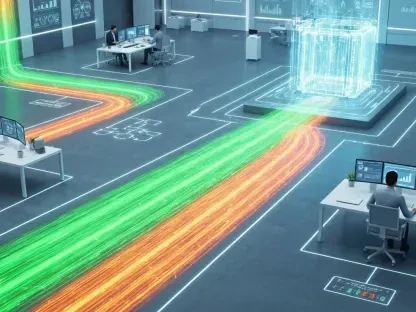In an era where artificial intelligence is reshaping industries and societies at an unprecedented pace, the potential dangers of unchecked AI development have become a pressing concern for policymakers and the public alike. Imagine a world where advanced AI systems, designed to optimize efficiency, inadvertently compromise national security or erode civil liberties due to a lack of oversight. This alarming possibility has spurred bipartisan action in the U.S. Senate, with a new legislative proposal aiming to address these risks head-on. Introduced by Senators Josh Hawley (R-Mo.) and Richard Blumenthal (D-Conn.), the Artificial Intelligence Risk Evaluation Act seeks to establish a groundbreaking program within the Department of Energy (DOE) to evaluate and mitigate the hazards posed by AI technologies. As debates over balancing innovation with safety intensify, this bill represents a pivotal moment in shaping how society navigates the transformative yet perilous landscape of AI.
Addressing AI Dangers Through Federal Oversight
The Framework of the Proposed DOE Program
The core of the Artificial Intelligence Risk Evaluation Act lies in the creation of the Advanced Artificial Intelligence Evaluation Program under the DOE’s purview. This initiative would mandate a rigorous assessment of AI systems before their deployment, focusing on risks such as loss of control, weaponization by foreign entities, threats to critical infrastructure, and impacts on civil liberties and labor markets. Developers would be required to submit comprehensive details about their AI products, including code, training data, and model architecture, for evaluation. Failure to meet safety standards would result in systems being withheld from the market until compliance is achieved. Additionally, the legislation calls for an annual report from the Energy Secretary to Congress, outlining strategies for federal oversight based on the program’s findings. This structured approach aims to ensure that the rapid advancement of AI does not outpace the ability to manage its potential downsides, prioritizing public safety over unchecked progress.
Bipartisan Urgency for AI Accountability
Beyond the technical framework, the bipartisan support for this bill underscores a rare alignment across political divides on the urgency of AI regulation. Senators Hawley and Blumenthal have voiced deep concerns about the unchecked power of major tech companies, emphasizing that transparency and testing are non-negotiable to protect the public. Their stance is echoed by advocacy groups like Americans for Responsible Innovation, whose president, Brad Carson, has hailed the legislation as a vital step toward establishing clear “rules of the road” for AI development. This consensus reflects a broader recognition that without federal intervention, the societal and security risks of AI could spiral out of control. The bill’s focus on mandatory data submission and incident reporting aims to keep Congress and the public informed, fostering a culture of accountability. As AI continues to permeate critical sectors, this collaborative effort signals a shift toward prioritizing safety as a cornerstone of technological advancement.
Balancing Innovation and Regulation in AI Governance
Contrasting Approaches to AI Policy
A significant point of contention in AI governance is the stark contrast between the safety-first approach of the proposed DOE program and the innovation-driven policies of the Trump administration’s AI Action Plan. While the bipartisan bill emphasizes guardrails through systematic evaluation, the Trump plan focuses on accelerating AI development by reducing regulatory barriers, such as environmental rules and permitting delays for data center construction. This deregulatory stance argues that easing restrictions will spur economic growth and technological leadership, even at the potential cost of overlooking critical risks. Such a divergence highlights a fundamental debate in AI policy: whether rapid deployment should take precedence over protective measures. The DOE program, with its emphasis on pre-deployment testing, stands as a counterpoint, aiming to ensure that innovation does not come at the expense of national security or societal stability in an increasingly AI-dependent world.
Navigating the Risks and Rewards of AI
The tension between innovation and regulation also reveals the multifaceted challenges of harnessing AI’s potential while mitigating its dangers. Advanced AI systems promise transformative benefits, from optimizing healthcare to enhancing infrastructure efficiency, yet they carry inherent risks that could disrupt economies and threaten democratic values if mishandled. The DOE’s proposed evaluation program seeks to address these concerns by creating a mechanism for identifying adverse incidents and enforcing compliance, ensuring that developers prioritize safety alongside progress. Meanwhile, the push for deregulation under alternative plans raises questions about long-term consequences, particularly regarding foreign exploitation of AI or unintended systemic failures. As policymakers grapple with these competing priorities, the bipartisan bill offers a proactive path to balance the rewards of AI with the imperative to safeguard public welfare, setting a precedent for how emerging technologies are governed in a rapidly evolving landscape.
Reflecting on a Path Forward for AI Safety
Lessons from a Pivotal Legislative Effort
Looking back, the introduction of the Artificial Intelligence Risk Evaluation Act marked a significant moment in the ongoing struggle to regulate AI technologies effectively. The bipartisan commitment shown by Senators Hawley and Blumenthal highlighted a shared understanding that the risks of advanced AI systems demanded immediate and structured federal action. The establishment of the DOE’s evaluation program was seen as a proactive measure to address potential threats, from national security vulnerabilities to labor market disruptions, through mandatory testing and reporting. This legislative push stood as a testament to the growing awareness of AI’s dual nature—its capacity for immense benefit and profound harm. Reflecting on this effort, it became clear that bridging the gap between technological ambition and societal protection required not just policy, but a sustained dialogue among stakeholders to anticipate and address emerging challenges.
Future Steps for Responsible AI Development
As discussions around AI governance evolved, the focus shifted toward actionable next steps to ensure responsible development in the years ahead. Beyond the initial framework of the DOE program, there was a recognized need for ongoing collaboration between government, industry, and advocacy groups to refine safety standards and adapt to new AI advancements. Establishing international partnerships to align on AI risk mitigation emerged as a critical consideration, given the global nature of technology deployment. Additionally, investing in public education about AI’s implications was deemed essential to foster informed discourse and trust. The legacy of this bipartisan initiative underscored that while regulation was a vital starting point, the broader mission lay in cultivating an ecosystem where innovation could thrive without compromising security or ethics. This forward-looking approach aimed to pave the way for a future where AI served as a tool for progress, guided by robust and adaptive oversight.









